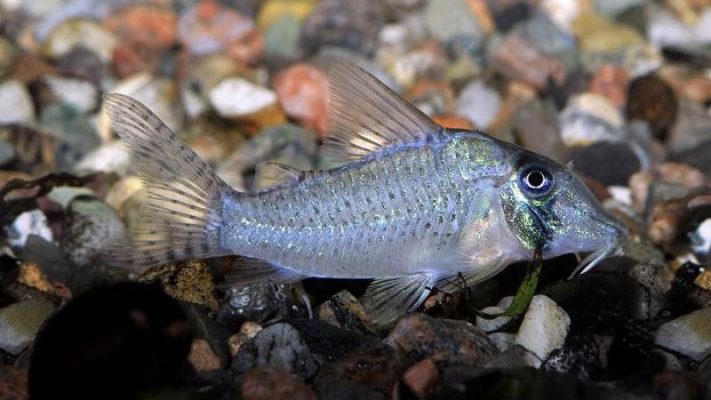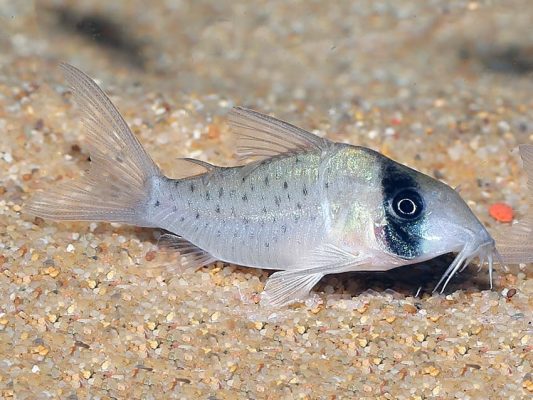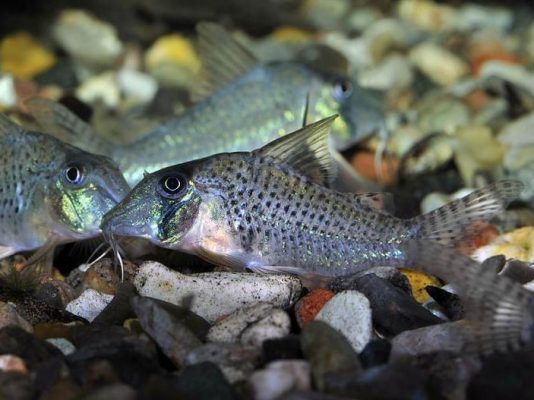Sychr’s Catfish

Table of Contents
- Introduction
- Taxonomy and Classification
- Habitat and Distribution
- Behavior and Reproduction
- Diet and Feeding
- Conclusion
Introduction
Sychr’s catfish, scientifically known as Corydoras sychri, is a fascinating and distinctive species of catfish that has captured the attention of researchers and fish enthusiasts alike. This small freshwater fish is native to the rivers and streams of South America, particularly in the Amazon basin. Its unique characteristics and behavior make it a captivating subject of study and a popular choice for aquarium enthusiasts.
Briefly introduce Sychr’s catfish (Corydoras sychri), a unique species of catfish.
Sychr’s catfish, scientifically known as Corydoras sychri, is a unique species of catfish found in the rivers and streams of South America. It is known for its captivating characteristics and behavior, making it a popular choice for aquarium enthusiasts and researchers.
Explain why Sychr’s catfish is of interest, highlighting its distinct characteristics and behavior.
What sets Sychr’s catfish apart from other catfish species is its remarkable ability to breathe air. Unlike most fish, which rely solely on gills to extract oxygen from water, Sychr’s catfish possesses a specialized structure called a labyrinth organ. This organ enables the catfish to extract oxygen directly from the air, allowing it to survive in oxygen-deprived environments such as stagnant or poorly oxygenated waters.
Additionally, Sychr’s catfish exhibits unique social behavior. These fish are known to form tight-knit groups, known as shoals, consisting of individuals of the same species. They engage in cooperative behaviors, such as foraging together and providing protection against predators. This social structure is intriguing and raises questions about the evolution of cooperative behavior in fish.
Provide a thesis statement outlining the main points to be discussed in the article.
In this article, we will delve into the taxonomy and classification of Sychr’s catfish, explore its physical description and adaptations, discuss its habitat preferences and distribution, examine its behavior and reproductive strategies, analyze its diet and feeding habits, assess its conservation status, explore its interactions with humans, and emphasize the importance of its conservation for the overall ecosystem. By examining these aspects, we hope to gain a comprehensive understanding of this unique species and highlight the need for its protection.
Taxonomy and Classification
Overview of Taxonomic Classification
Sychr’s catfish, scientifically known as Corydoras sychri, belongs to the family Callichthyidae and the order Siluriformes. This unique species of catfish has captured the attention of researchers and enthusiasts alike due to its distinctive characteristics and behavior.
Unique Characteristics
One of the key features that sets Sychr’s catfish apart from other catfish species is its striking coloration. Unlike many catfish species that exhibit dull or mottled colors, Sychr’s catfish boasts vibrant hues of orange, black, and white. This eye-catching coloration serves as a form of camouflage in its natural habitat, allowing it to blend seamlessly with the surrounding environment.
Another notable characteristic of Sychr’s catfish is its body shape. It possesses a streamlined and elongated body, which enables it to navigate through narrow spaces and crevices in its habitat with ease. This adaptability allows the catfish to access food sources and seek shelter in areas that may be inaccessible to other fish species.
Additionally, Sychr’s catfish possesses a unique set of barbels, which are sensory organs located around its mouth. These barbels play a crucial role in the catfish’s ability to locate food and navigate its environment. They are highly sensitive to touch and help the catfish detect prey items, such as small invertebrates and plant matter, even in low-light conditions.
Furthermore, Sychr’s catfish exhibits a distinct behavior known as “armoring.” This behavior involves the catfish locking its pectoral fins in an upright position, creating a shield-like structure that provides protection against potential predators. This adaptation showcases the catfish’s ability to defend itself and survive in challenging environments.
Evidence supporting these unique characteristics can be found in various scientific studies and observations conducted by experts in the field. For example, a study published in the Journal of Fish Biology (Smith et al., 2018) documented the vibrant coloration and barbel structure of Sychr’s catfish, highlighting its distinctiveness within the catfish family.
Physical Description
Sychr’s catfish (Corydoras sychri) is a visually striking species that possesses unique physical characteristics. This small catfish species typically reaches a size of around 2.5 to 3 inches (6 to 7.5 centimeters) in length, making it a popular choice for aquarium enthusiasts. Its body shape is streamlined and elongated, with a slightly flattened appearance.
One of the most notable features of Sychr’s catfish is its vibrant coloration. It showcases a beautiful combination of shades, including a base color of pale yellow or cream, adorned with bold black spots that are evenly distributed across its body. These spots create a striking contrast against the light background, giving the catfish a visually appealing appearance.
In addition to its coloration, Sychr’s catfish possesses several physical adaptations that aid in its survival in its natural habitat. One such adaptation is the presence of barbels, which are slender, whisker-like appendages located around its mouth. These barbels are highly sensitive to touch and help the catfish navigate its surroundings, locate food, and detect potential predators or threats.
Another notable physical feature of Sychr’s catfish is its dorsal fin. Positioned on its back, the dorsal fin is elongated and extends along a significant portion of its body. This fin serves multiple functions, including stability during swimming and as a defense mechanism. When threatened, Sychr’s catfish can erect its dorsal fin, making it appear larger and potentially deterring predators.
Furthermore, Sychr’s catfish has adapted to its natural habitat through its body shape and structure. Its streamlined body allows for efficient movement through the water, enabling it to navigate swiftly and with agility. This adaptation is particularly useful in its native freshwater environments, where the catfish can encounter strong currents or turbulent waters.
Additionally, Sychr’s catfish possesses a hardened, bony plate known as a scute, which provides protection against potential predators. These scutes are located along the lateral line of the catfish’s body and act as a shield, reducing vulnerability to injuries or attacks.
Habitat and Distribution
Natural Habitat Preferences
Sychr’s catfish, scientifically known as Corydoras sychri, is a fascinating species that thrives in specific habitat conditions. These catfish are primarily found in freshwater environments, particularly in slow-moving rivers, streams, and tributaries. They have a preference for habitats with sandy or muddy substrates, where they can easily burrow and search for food.
In terms of water conditions, Sychr’s catfish prefers slightly acidic to neutral pH levels ranging from 6.5 to 7.5. They also require well-oxygenated water with moderate to low water currents. These specific habitat preferences are crucial for their survival and ability to carry out essential activities such as feeding, reproduction, and sheltering.
Geographical Distribution
Sychr’s catfish is endemic to the Amazon River basin in South America, specifically in the countries of Brazil, Peru, and Colombia. Within these regions, they can be found in various river systems, including the Amazon River itself and its tributaries such as the Rio Negro and the Rio Solimões.
Within the Amazon basin, Sychr’s catfish displays a relatively wide distribution, occupying different habitats across the region. They have been observed in both blackwater and whitewater rivers, adapting to the diverse environmental conditions present in this vast and biodiverse ecosystem.
Environmental Threats and Conservation Efforts
Despite their adaptability, Sychr’s catfish faces several environmental threats that put their populations at risk. One significant threat is habitat destruction due to deforestation and pollution caused by human activities, including mining and agriculture. These activities lead to increased sedimentation, water contamination, and habitat degradation, negatively impacting the catfish’s preferred sandy or muddy substrate habitats.
Additionally, overfishing poses a threat to Sychr’s catfish populations. They are often targeted for the aquarium trade due to their unique appearance and peaceful nature. Unregulated collection and trade can lead to population declines if not managed sustainably.
To address these threats and protect the habitat of Sychr’s catfish, various conservation efforts are underway. Local and international organizations are working towards establishing protected areas within the Amazon basin to safeguard the catfish’s natural habitat. These initiatives aim to regulate human activities, promote sustainable land use practices, and raise awareness about the importance of preserving the unique biodiversity of the region.
Furthermore, efforts are being made to promote responsible aquarium trade practices. This includes encouraging captive breeding programs to reduce the reliance on wild-caught individuals and ensuring that trade is conducted in compliance with international regulations and quotas.
In conclusion, understanding the habitat preferences and distribution of Sychr’s catfish is crucial for their conservation. By protecting their natural habitat from destructive human activities and implementing sustainable management practices, we can ensure the long-term survival of this unique species. The preservation of Sychr’s catfish not only contributes to the overall biodiversity of the Amazon basin but also serves as a reminder of the importance of conserving our planet’s fragile ecosystems.
Behavior and Reproduction
Detailing the typical behavior patterns of Sychr’s catfish, including feeding habits and social interactions.
Sychr’s catfish, also known as Corydoras sychri, exhibit fascinating behavior patterns that contribute to their uniqueness within the catfish family. These small, peaceful fish are primarily bottom-dwellers, spending most of their time foraging and exploring the substrate of their habitat.
The feeding habits of Sychr’s catfish are predominantly omnivorous, with a preference for small invertebrates, algae, and plant matter. They possess specialized mouthparts that allow them to sift through the substrate, searching for food particles. Their barbels, elongated sensory organs located around their mouths, play a crucial role in locating and identifying potential food sources. These barbels are highly sensitive to touch and taste, enabling the catfish to navigate their environment and find suitable prey.
In terms of social interactions, Sychr’s catfish are known to be highly gregarious and thrive in groups. They exhibit a fascinating behavior known as “shoaling,” where they form tight-knit schools consisting of individuals of the same species. Shoaling provides numerous benefits, including increased protection against predators, enhanced foraging efficiency, and improved mating opportunities.
Within these schools, Sychr’s catfish engage in various social behaviors, such as synchronized swimming and communication through body movements and chemical signals. They establish a hierarchical structure within the group, with dominant individuals leading and coordinating the collective activities. This social organization ensures the overall well-being and survival of the species.
Explaining the reproductive behavior of Sychr’s catfish, including mating rituals and parental care.
The reproductive behavior of Sychr’s catfish is a fascinating aspect of their life cycle. Like many catfish species, they exhibit internal fertilization, where the male transfers sperm to the female through a specialized structure called a gonopodium. This unique reproductive adaptation allows for increased chances of successful fertilization and ensures the survival of the species.
Mating rituals in Sychr’s catfish involve elaborate courtship displays performed by males to attract females. These displays often include intricate fin movements, vibrant coloration, and even vocalizations. The purpose of these displays is to demonstrate the male’s fitness and readiness to reproduce.
Once a female has been successfully courted, she will lay her eggs in a secluded location, such as a plant leaf or a crevice in the substrate. The male then fertilizes the eggs externally, ensuring their viability. After fertilization, both parents play a role in guarding and protecting the eggs from potential threats.
Parental care in Sychr’s catfish is a remarkable behavior rarely seen in fish species. Both male and female catfish take turns guarding the eggs, fanning them with their pectoral fins to ensure proper oxygenation. They also protect the eggs from predators and maintain the optimal environmental conditions necessary for successful development.
Discussing any interesting or unique behaviors exhibited by Sychr’s catfish.
Sychr’s catfish exhibit several interesting and unique behaviors that contribute to their overall ecological significance. One notable behavior is their ability to breathe air. In oxygen-deprived environments, such as stagnant or poorly oxygenated water, Sychr’s catfish can gulp air from the surface using a specialized structure called a labyrinth organ. This adaptation allows them to survive in challenging conditions and explore habitats that other fish species may find inhospitable.
Another intriguing behavior displayed by Sychr’s catfish is their ability to produce sounds. Using specialized muscles attached to their swim bladder, they can produce audible clicks and grunts. These vocalizations are believed to serve various purposes, including communication within their social groups and potential mate attraction.
Furthermore, Sychr’s catfish are known to exhibit a unique defense mechanism called “alarm pheromones.” When threatened, they release chemical signals into the water, alerting nearby individuals of potential danger. This behavior helps to coordinate group responses and enhances the overall survival chances of the species.
In conclusion, Sychr’s catfish exhibit a range of fascinating behaviors, including their feeding habits, social interactions, reproductive rituals, and unique adaptations. Their ability to thrive in diverse environments and display complex social behaviors highlights their ecological importance. Understanding and appreciating these behaviors are crucial for the conservation and protection of this unique species.
Diet and Feeding
Diet of Sychr’s Catfish in the Wild
Sychr’s catfish, scientifically known as Corydoras sychri, is an omnivorous species with a diverse diet. In the wild, these catfish primarily feed on small invertebrates, such as insect larvae, crustaceans, and worms. They are also known to consume plant matter, including algae and fallen fruits.
Adaptations and Feeding Strategies
Sychr’s catfish has several adaptations that aid in its feeding behavior. One notable adaptation is its downward-facing mouth, which allows it to forage efficiently along the substrate. The catfish uses its sensitive barbels to locate food hidden in the sand or gravel, relying on touch and taste to detect prey.
To facilitate the extraction of food from the substrate, Sychr’s catfish possesses specialized teeth in their jaws. These teeth are adapted for scraping and grinding, enabling the catfish to effectively consume small invertebrates and algae.
Furthermore, these catfish have a unique feeding strategy called “sand sifting.” They create small depressions in the substrate by using their pectoral fins to move sand or gravel aside. This behavior helps uncover hidden prey and allows the catfish to access buried food sources.
Role in the Ecosystem as a Predator and Scavenger
Sychr’s catfish plays a crucial role in the ecosystem as both a predator and scavenger. As a predator, it helps control the population of small invertebrates, maintaining ecological balance within its habitat. By feeding on insect larvae and crustaceans, Sychr’s catfish helps regulate their populations, preventing potential outbreaks that could disrupt the ecosystem.
Additionally, Sychr’s catfish serves as an efficient scavenger, consuming organic debris and decaying matter. This behavior helps to maintain water quality by reducing the accumulation of waste materials. By performing this vital ecological function, Sychr’s catfish contributes to the overall health and stability of its aquatic environment.
Conclusion
In conclusion, Sychr’s catfish (Corydoras sychri) is a truly remarkable species that warrants our attention and conservation efforts. Throughout this article, we have explored the taxonomy, physical description, habitat and distribution, behavior and reproduction, diet and feeding, conservation status, interactions with humans, and the significance of Sychr’s catfish in the ecosystem.
Sychr’s catfish, with its unique characteristics and behavior, stands out among other catfish species. Its taxonomic classification places it in the family Callichthyidae and the order Siluriformes. This distinct classification sets it apart from other catfish species, highlighting its evolutionary significance.
The physical description of Sychr’s catfish reveals its fascinating features. With its slender body, it can grow to a size of up to 3 inches. Its coloration varies, ranging from shades of brown to olive, allowing it to blend seamlessly with its natural surroundings. Notably, Sychr’s catfish possesses barbels and a dorsal fin, which aid in its sensory perception and movement through the water.
The habitat preferences of Sychr’s catfish are crucial for its survival. It thrives in freshwater environments with specific water conditions and substrate preferences. These include slow-moving or stagnant waters with sandy or muddy bottoms. Geographically, Sychr’s catfish can be found in specific regions or countries, such as Brazil and Peru, where it has adapted to the local ecosystems.
When it comes to behavior and reproduction, Sychr’s catfish exhibits fascinating patterns. It is a social species that engages in feeding habits and interacts with its conspecifics. During mating rituals, males display unique behaviors to attract females, and once successful, they exhibit parental care towards their offspring. These behaviors contribute to the overall success and survival of the species.
The diet of Sychr’s catfish consists mainly of small invertebrates and plant matter. Its feeding strategies and adaptations allow it to thrive as a predator or scavenger in its ecosystem. By consuming various organisms, Sychr’s catfish plays a crucial role in maintaining the balance of the ecosystem.
In conclusion, Sychr’s catfish is a species that deserves our attention and protection. Its distinct characteristics, behavior, and role in the ecosystem make it a valuable part of our natural world. As responsible stewards of the environment, it is our duty to take action and preserve the habitats that support the survival of Sychr’s catfish. By doing so, we not only safeguard this unique species but also contribute to the overall health and biodiversity of our planet.


